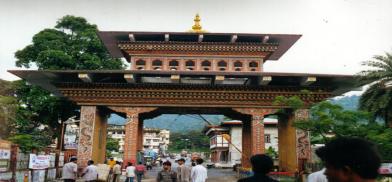Guarding Bhutan's porous border with India
In Umling, Gelephu, an irrigation channel separates officials from Royal Manas National Park (RMNP) in Bhutan on COVID-19 duty from nearby Indian settlements in the state of Assam

In Umling, Gelephu, an irrigation channel separates officials from Royal Manas National Park (RMNP) in Bhutan on COVID-19 duty from nearby Indian settlements in the state of Assam. Here the chances of people moving from across the border are high. There were few cases of people trying to cross borders in the beginning, according to the forestry officials.
The foresters from RNMP are able to continue their required surveillance along the border with the additional manpower support from Zhemgang, Bumthang, and Wangdue in the wake of the COVID-19 pandemic.
“It was challenging in the beginning. We had to provide services to the people and also had to be on duty with the limited manpower,” said Samten Wangchuk, chief forestry officer with RMNP. “But, we are in good shape now. The department has provided us with additional teams.”
He added that the people are aware of their presence. “There was no case of people trying to intrude. It’s a rare opportunity for us to serve the nation in these critical times,” he said.
There are over 35 forestry officials placed in four different points of entry in Umling today. The officials from the national land commission had also supported the team in the beginning.
During the initial phase of the duty, the officials in Umling had to stay in the observation points for 24 hours without shift. There were only two groups to look after four OPs in the gewog.
The foresters guarding the point of entries along the Maokhola river stretch in Gelephu withdraw from their observation points when it starts to rain today.
The officials stationed overnight at observation points along the border are temporarily replaced by frequent patrolling since the recent flash flood at Maokhola stranded four forestry officials who were on COVID-19 duty.
These are some of the challenges facing the guards along borders, trying to secure porous borders from the coronavirus outbreak to date.
In Sarpang, over 140 foresters in divisional forest office Sarpang, Phibsoo Wildlife Sanctuary, and RMNP are placed along the borders to prevent the movement of intruders.
Seven points of entry are manned by foresters along Moakhola stretch and at Gakiling-Sisty area near the border.
There are also reinforcement officials from divisional forest office Tsirang and Wangdue on the COVID-19 duty in the dzongkhag.
Chief forestry officer, Sarpang, Phub Dhendup, said the service delivery was continuing unhampered. There are separate staff for service delivery and those on COVID-19 duty.
“The foresters on duty could prevent few cases of people trying to move across the border,” he said. “Most areas manned by foresters are along borders that have thick covers. But, it’s not so different from other officials who are on the same duty.”
The official added that the 24 hours watch along the borders also reduced the incidences of illegal fishing, felling and logging along the borders.
These activities were happening frequently along borders in the past.
Stationed along the border, the foresters endure subtropical region risk of unexpected flash floods during monsoon while guarding the borders.
“The recent outbreak of malaria and dengue, and the pressure from wild elephants are some of the challenges facing the officials on duty,” said Phub Dhendup.” But, most officials have the experience of working under such situations.”
Chief Forestry Officer with Phibsoo Wildlife Sanctuary, Dorji Rabten, said the risk of community transmission was high should there be weak surveillance along the porous border in the southern region.
“The illegal transaction of alcohol and tobacco products along the borders are under control today. There are several informal routes that allowed these illegal trades in the past,” he said.
https://kuenselonline.com/guarding-the-porous-border-in-sarpang/









Post a Comment